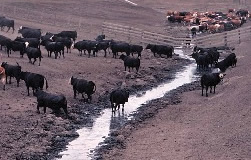Hello everyone! Although it is our 5th and final week into the GE3246 Special Term module, and we are still learning new things about agricultural pollution and can’t wait to share them with you guys (:

Livestock waste deposited directly into water body
The manure from livestock can be very problematic. This is the case whether uncontrolled release of waste or when initially placing them into lagoons.
In particular, uncontrolled livestock waste is a direct source of pollution for surface and groundwater sources. Their mixing with surface water can severely impact the water quality and cause the death of living organisms. Not only that, there is a high Biological Oxygen Demand due to the organic materials found in waste. Their waste is a source of atmospheric ammonia, carbon dioxide, methane and nitrous oxide. These excess nutrients and organic matter is a stimulant for growth of algae in water bodies. The heavy metals and harmful bacteria directly found in animal waste could also leach into and contaminate water supplies. Also not to mention, there are traces of ammonia and bad odour when there is a spread of this waste slurry across the land.
We tend to assume that if the animal manure is managed, there would be no problems at all. However, this is not true. Let me explain why! Animal wastes are stored in pits or open ponds, otherwise known as lagoons. These “waste containers” are hastily dug, they do not have a lining to prevent leaching of harmful pollutants. In the case of large storms, these containers might even be torn apart, spilling out all the animal waste slurry in a horrific sight! In order to combat this problem, some large-scale farms spray this spilt manure onto the farm fields. The environmental pollution caused by all the raptured lagoons, spraying and leaching can be very detrimental. Surface and groundwaters get contaminated with excess nutrients from animal waste. Nitrates, heavy metals or even pathogenic bacteria can leach into water supplies, causing morbidity and illness.
It is estimated that a total of 2 billion tonnes of liquid fraction and waste is generated annually from US alone, while China’s livestock farms generate nearly 4 billion tonnes of waste annually. Hence, with lots of meat consumers around, many livestock has to be reared, causing a lot of pollution to enter aquatic ecosystems or even water supplies. However, as consumers, we don’t often see the direct impacts from our consumption, as the pollution is outsourced to countries which rely on agriculture as their main source of revenue.
References:
Polat, H. and Olgun, M., 2006. Water pollution from livestock wastes and required strategies in efforts to adapt to European Union. International Water Association,.
FoodPrint. 2020. How Industrial Agriculture Causes Water Pollution | Foodprint. [online] Available at: <https://foodprint.org/issues/how-industrial-agriculture-affects-our-water/> [Accessed 20 July 2020].
Gu, H. and Mason, J., 2017. Energy Hogs: China Targets Farm Waste As A ‘Clean’ Power Source. [online] U.S. Available at: <https://www.reuters.com/article/us-china-livestock-waste/energy-hogs-china-targets-farm-waste-as-a-clean-power-source-idUSKCN1BA16V#:~:text=Chinese%20livestock%20farms%20generate%20nearly,according%20to%20the%20agriculture%20ministry.> [Accessed 20 July 2020].